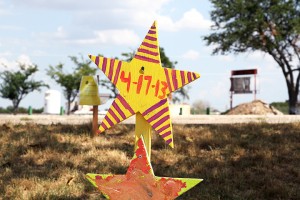[timelinexml]
West Explosion and Recovery Timeline

Travis Taylor | Lariat Photo Editor
By Paula Ann Solis
Staff Writer
During the months following the April 17 fertilizer plant explosion in West that destroyed 100 homes and killed 15 people, the Baylor community has continued to offer support through a physical presence and large monetary donations.
The university created a West Relief Fund the week the explosion happened and by July 10, the fund had raised more than $290,000, the entirety of which was donated to the First Baptist Church of West.
The decision to offer Baylor’s donation to the church was based on a long assessment of where the needs for West residents were greatest, Lori Fogleman, assistant vice president for media communications, said.
Fogleman also said it was important to the university that the people of West were part of the decision and, after considering input from various sources, the demolition project by First Baptist was confirmed as the best way to serve the community.
First Baptist had already begun a partnership with the nonprofit organization Texas Baptist Men and was using the personal church funds to help West residents.
“We worked closely with the Waco Foundation and with the West Long-Term Recovery Committee, two very important entities, to find the most meaningful way that the city could use these funds,” Fogleman said.
In July, the church began phase one of the demolition project. With 60 homes still in need of demolition, funds for the relief efforts began depleting fast. When the donation from Baylor was announced, however, it ensured the ongoing demolition efforts would continue.
The West Long-Term Recovery Committee led phase two efforts with the help of the donation given to First Baptist.
“It was providential that we happened to have a little over $290,000 and what was needed for the remainder of the debris removal project was nearly the exact amount,” Fogleman said. “We managed to find a project that needed exactly what we had raised.”
West Mayor Tommy Muska said a simple “thank you” would never be enough to show the city’s gratitude towards both the financial contributions and the labor that has been put in by the Baylor community.
Part of that labor includes Baylor students who have donated time to help with the debris removal and cleaning projects over the summer.
Because of the work during the summer, Muska said, West Middle School would be open today for students’ first day of classes and only one home in West is awaiting demolition.
Muska said he expected the relief efforts to slow down as students left Waco for their hometowns. He said his expectations have been wrong.
“Baylor has really stepped up, proving that they really are a first-class college,” Muska said. “It takes your breath away to think of the humanity that has been shown to West.”
While Muska said progress is being made and many residents, including those in zone three, will begin moving back into their homes mid-September, the work in West is proving to be long-term.
Baylor students and others looking for ways to stay informed on volunteer needs in West can use the Facebook page developed by Erin Payseur, Baylor’s Associate Director for Community-Based Learning. Payseur created the page “Baylor Supports West” the day after the explosion as an open forum for students, alumni and the community to stay informed.
“When West happened, we knew we needed a way to disseminate accurate information to those who were looking to get involved,” Payseur said.
Though a Baylor official created the Facebook page, it is not a university-organized relief effort, Payseur said. It is only meant to be a guide to those who want to help on their own. Fogleman said this effort by the student body to remain involved, even in an unofficial mode, does not surprise her.
“The volunteering by Baylor students and alumni demonstrates the essential element of Baylor’s mission, service to others, whether alone or part of a group,” Fogleman said.
For more information on the relief efforts in West, visit the West Long-Term Recovery website westltr.org or Baylor’s relief website www.baylor.edu/relief.






